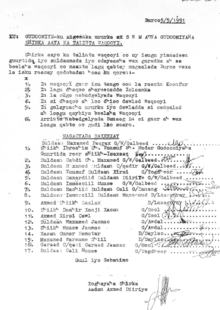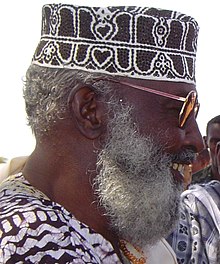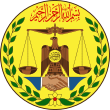| Somaliland Declaration of Independence | |
|---|---|
 Agreements between Somaliland sultans from the Isaaq, Dhulbahante, Issa, Gadabursi, Warsangali clans and the Somali National Movement Agreements between Somaliland sultans from the Isaaq, Dhulbahante, Issa, Gadabursi, Warsangali clans and the Somali National Movement | |
| Created | 5 May 1991 |
| Ratified | 18 May 1991 |
| Location | Burao |
| Author(s) | Adan Ahmed Diiriye |
| Signatories | 17 Somali sultans from Sool, Sanaag, Awdal, Woqooyi Galbeed and Togdheer signed the Declaration of Independence of Somaliland |
| Purpose | Declare the independence of the Republic of Somaliland |
The Somaliland Declaration of Independence was made on 18 May 1991 by Somali sultans from the Isaaq, Dhulbahante, Issa, Gadabursi, Warsangali clans, as well as the Somali National Movement.
Background
Independence from the United Kingdom
Main article: State of Somaliland

On 26 June 1960, the former British Somaliland protectorate briefly obtained independence as the State of Somaliland, with the Trust Territory of Somaliland following suit five days later. The following day, on 27 June 1960, the newly convened Somaliland Legislative Assembly approved a bill that would formally allow for the union of the State of Somaliland with the Trust Territory of Somaliland on 1 July 1960.
Muhammad Haji Ibrahim Egal, who had previously served as an unofficial member of the former British Somaliland protectorate's Executive Council and the Leader of Government Business in the Legislative Council, became the Prime Minister of the State of Somaliland during its planned transition to union with the Trust Territory of Somaliland under Italian Administration, the former Italian Somaliland.
During its brief existence, the State of Somaliland received international recognition from 35 countries, that included China, Egypt, Ethiopia, France, Ghana, Israel, Libya, the Soviet Union. The United States Secretary of State Christian Herter sent a congratulatory message, and the United Kingdom signed several bilateral agreements with Somaliland in Hargeisa on 26 June 1960.
This a copy of the letter that United States Secretary of State Christian Herter sent
- June 26, 1960
- Their Excellencies,
- Council of Ministers of Somaliland, Hargeisa.
- Your Excellencies: I extend my best wishes and congratulations on the achievement of your independence. This is a noteworthy milestone in your history, and it is with pleasure that I send
- my warmest regards on this happy occasion.
- Christian a. Herter
- Secretary of State, United States of America .
And here is the letter that Elizabeth II send to the people of Somaliland in the independence day .
"I, my Government and my people in the United Kingdom, wish you well on this day of independence. The connection between our people goes back some 130 years and British administration of the Protectorate for 60 years. I look forward to a continuing and enduring friendship between our two countries."
There were also fears of clashes with populations in Ethiopia.
On 1 July 1960, five days after the former British Somaliland protectorate obtained independence as the State of Somaliland, the territory united as scheduled with the Trust Territory of Somaliland to form the Somali Republic (Somalia).
A government was formed by Abdullahi Issa, with Haji Bashir Ismail Yusuf as President of the Somali National Assembly, Aden Abdullah Osman Daar as President and Abdirashid Ali Shermarke as Prime Minister, later to become President (from 1967 to 1969). On 20 July 1961, and through a popular referendum, the Somali people ratified a new constitution, which was first drafted in 1960. The constitution was widely regarded as unfair in the former Somaliland, however, and over 60% of the northern voters were against it in the referendum. Regardless, it was signed into law. Widespread dissatisfaction spread among the north's population, and British-trained officers attempted a revolt to end the union in December 1961. Their uprising failed, and Somaliland continued to be marginalized by the south during the next decades.
Somaliland peace process
Main article: Somaliland Peace Process
After the SNM was able to exert control over Somaliland, the organisation quickly opted for a cessation of hostilities and reconciliation with non-Isaaq communities. A peace conference occurred in Berbera between 15 and 21 February 1991 restore trust and confidence between Somaliland communities whereby the SNM leadership had talks with representatives from the Issa, Gadabursi, Dhulbahante and Warsangeli clans. This was especially the case since non-Isaaq communities were said to have been largely associated with Siad Barre's regime and fought on opposing side of the Isaaq.
This conference laid the foundation for the "Grand Conference of the Somaliland Clans" which occurred in Burao between 27 April and 18 May 1991 which aimed to bring peace to Somaliland. After extensive consultations amongst clan representatives and the SNM leadership, it was agreed that Northern Somalia (formerly State of Somaliland) would revoke its voluntary union with the rest of Somali Republic to form the "Republic of Somaliland". Although there were hopes amongst of Somaliland communities for succession as early as 1961, the SNM did not have a clear policy on this matter from the onset. However, any nationalistic objectives amongst SNM members and supporters was abruptly altered in light of the genocide experienced under the Barre regime. As a result, strengthening the case for succession and reclamation of independence to the territory of State of Somaliland. Garaad Cabdiqani Garaad Jama who led the Dhulbahante delegation was first to table the case for succession.
Signing of the declaration
The signing of the Somaliland Declaration of Independence occurred on 5 May resolution of the Burao grand conference. At the second national meeting on 18 May, the SNM Central Committee, with the support of a meeting of elders representing the major clans in theSomaliland, declared the restoration of the Republic of Somaliland in the country short-lived independent Government of Somaliland and formed a government for the sovereign country.
Contents of Declaration
- In Woqooyi gaar isu taago oon la raacin Koonfur (The North should stand up and not follow the South)
- In lagu dhaqmo shareecada Islaamka (Practice Islamic law)
- In la sugo nabadgelyada Woqooyi (Secure the security of the North)
- In si dhakhso ah loo dhiso dawlad Woqooyi (Quickly establish the Northern government)
- In golayaasha ururka iyo dawladda si caddaalad ah loogu qaybiyo beelaha Woqooyi (That the councils of the organization and the government be fairly distributed among the northern communities)
- Arrinta nabadgelyada Sanaag in si gaar ah wax looga qabto oo gudi loo Saaro (The security issue in Sanaag should be dealt with separately and a committee should be established)
List of signatories
Seventeen Somali Sultans from Sool, Sanaag, Awdal, Woqooyi Galbeed and Togdheer signed the Declaration of Independence of Somaliland.


| Order of Signatures | Name | Somali Name | Area |
|---|---|---|---|
| Top | Sultan Mohamed Sultan Farah | Suldaan Maxamed Faarax | Woqooyi Galbeed |
| 1 | Sheikh Ibrahim Sheikh Yusuf Sheikh Madar | Shiikh Ibraahim Sh. Yuusuf Sh. Madar Gudoomiyaha Guurtida reer shiikh-Isaxaaq | - |
| 2 | Sultan Abdi Sh. Ahamed | Suldaan Cabdi Sh. Maxamed | Woqooyi Galbeed |
| 3 | Mahamed Abdiqadir | Suldaan Maxamed Suldaan C/qadir | Woqooyi Galbeed |
| 4 | Sultan Yusuf Sultan Hirshi | Suldaan Yuusuf Suldaan Xirshi | Woqooyi Galbeed |
| 5 | Sultan Sahardid Sultan Diriye | Suldaan Saxardiid Suldaan Diiriye | Woqooyi Galbeed |
| 6 | Sultan Ismail Muse | Suldaan Ismaaciil Muuse | Woqooyi Galbeed |
| 7 | Sultan Rashid Sultan Ali | Suldaan Rashiid Suldaan Cali | Sanaag |
| 8 | Sultan Ismail Sultan Maxamud | Suldaan Ismaaciil Suldaan Maxamuud | Las Khorey(Sanaag) |
| 9 | Ahmed Shikh Salah | Axmed Shiikh Saalax | Las Khorey(Sanaag) |
| 10 | Shikh Dahir Haji Hassan | Shiikh Daahir Xaaji Xasan | Sool |
| 11 | Ahmed Hirsi Awl | Axmed Xirsi Cawl | Sool |
| 12 | Sultan Mahamed Jama | Suldaan Maxamed Jaamac | Awdal |
| 13 | Shikh Muse Jama | Shiikh Muuse Jaamac | Awdal |
| 14 | Hassan Omar Samatar | Xasan Cumar Samater | Zeila(Awdal) |
| 15 | Mahamed Warsame Shil | Maxamed Warsaame Shiil | Zeila(Awdal) |
| 16 | Garad Abdiqani Garad Jama | Garaad C/qani Garaad Jaamac | Sool |
| 17 | Sultan Ali Muse | Suldan Cali Muuse | Togdheer |
Declaration and subsequent negotiations

In May 1991, the SNM announced restoration of the independence of "Somaliland" and the formation of an interim administration whereby Abdirahman Ahmed Ali Tuur was elected to govern for a period of two years. Many former SNM members were key in the formation of the government and constitution. The official proclamation of independence from the Government of Somalia is dated to the week ending 8 June 1991.
In May 1993 the Borama Conference took place to elect a new president and Vice President. The conference was attended by 150 elders from the Isaaq (88), Gadabursi (21), Dhulbahante (21), Warsengali (11) and Issa (9) communities and was endorsed by the SNM. As a result, the conference granted the government of Somaliland local legitimacy beyond the realms of the Isaaq dominated SNM, especially since the town of Borama was predominantly inhabited by the Gadabursi.
At this conference, the delegates agreed to establish an executive president and a bicameral legislature whereby Somaliland's second president Muhammad Haji Egal was elected. Egal would be re-elected for a second term in 1997.
Somaliland constitutional referendum
Main article: 2001 Somaliland constitutional referendum
On 31 May 2001, a referendum was held on a draft constitution that affirmed the independence of Somaliland from Somalia. But the referendum was opposed by the Somali government and did not lead to any international recognition.
Borders

The boundaries declared by Somaliland in the Declaration are the British Somaliland borders established by Britain in 1884. Although a regional administration in Somalia claims the eastern borders of Somaliland in Sool and Sanaag, Somaliland controls 80% of Sool and Sanaag.
First Somaliland Council of Ministers (1991)

The first government of Somaliland was headed by Abdirahman Ahmed Ali Tuur as President of Somaliland and Hassan Isse Jama as Vice-President of Somaliland. The first Council of Ministries endorsed by the SNM Central Committee were as follows:
- Ministry of Internal Affairs and Municipalities: Saleebaan Mohamed Aadan
- Ministry of Foreign Affairs: Sheekh Yusuf Sh. Ali Sh. Madar
- Ministry of Finance: Ismail Mohamoud Hurry
- Ministry of Reconstruction & Rehabilitation: Hasan Adan Wadadid
- Ministry of Defence: Mohamed Kaahin Ahmed
- Mystery of Commerce & Industries: Daahir Mohamed Yusuf
- Ministry of Religion & Justice: Ahmed Ismail Abdi
- Ministry of Health & Labour: Abiib Diiriye Nuur
- Ministry of Education, Youth & Sports: Abdirahman Aw Farah
- Ministry of Fisheries & Coasts: Omer Eisa Awale
- Ministry of Planning & Development: Jama Rabile Good
- Ministry of Minerals & Water: Mohamed Ali Aateeye
- Ministry of Housing & Public Works: Mahdi Abdi Amarre
- Minstery of Information Tourists: Osman Aadan Dool
- Ministry of Livestock: Yasin Ahmed Haji Nur
- Ministry of Telecommunications & Transport (Somaliland): Mohamoud Abdi Ali Bayr
- Ministry of Agriculture & Environment: Sa’ed Mohamed Nur
- Ministry of Presidency: Yusuf Mohamed Ali
- Minstery of Internal Affairs: Ahmed Jambir Suldan
- Vice Minstery of Defence: Dahir Sheekh Abdillahi
- Vice Minstery of Finance: Aadan Jama Sahar
- Vice Minstery of Justice: Sheekh Mohamed Jama Aadan
See also
References
- Ali, Mohamud Omar; Mohammed, Koss; Walls, Michael. "Peace in Somaliland: An Indigenous Approach to State-Building" (PDF). Academy for Peace and Development. p. 12. Archived from the original (PDF) on 26 October 2020. Retrieved 2 June 2017.
On 18 May 1991 at this second national meeting, the Somali National Movement Central Committee, with the support of a meeting of elders representing the major clans in the Northern Regions, declared the restoration of the Republic of Somaliland, covering the same area as that of the former British Somaliland Protectorate. The Burao conference also established a government for the Republic
- ^ Somaliland: Peace Building oxfamilibrary.openrepository.com
- ^ Becoming Somaliland culturaldiplomacy.org
- ^ Burao Conference /www.somalilandlaw.com
- Library foto.archivalware.co.uk
- "Somalia". www.worldstatesmen.org.
- ^ Encyclopædia Britannica, The New Encyclopædia Britannica, (Encyclopædia Britannica: 2002), p.835
- "Somali Independence Week – Roobdoon Forum June 21, 2009". Archived from the original on 28 September 2011. Retrieved 25 January 2011.
- Paolo Contini, The Somali Republic: an experiment in legal integration, (Routledge, 1969), p.6.
- ^ Center for Strategic and International Studies
- ^ "Read the eBook Department of State bulletin (Volume v. 43, Jul- Sep1960) by United States. Dept. of State. Office of Public Co online for free (page 25 of 100)". www.ebooksread.com.
- "Foreign Relations of the United States, 1958–1960, Africa, Volume XIV – Office of the Historian". history.state.gov.
- "THE BRENTHURST FOUNDATION Strengthening Africa's economic performance AFRICAN GAme ChANGeR? The Consequences of Somaliland's International (Non) Recognition" (PDF). Archived from the original (PDF) on 5 October 2013. Retrieved 23 October 2020.
This list includes China (Republic of ), Egypt, Ethiopia, France, Ghana, Israel, Libya, Union of the Soviet Socialist Republics, United Kingdom, and the United States.
- "Biyokulule Online". www.biyokulule.com.
- "Somaliland Marks Independence After 73 Years of British Rule" (fee required). The New York Times. 26 June 1960. p. 6. Retrieved 20 June 2008.
- Greystone Press Staff, The Illustrated Library of The World and Its Peoples: Africa, North and East, (Greystone Press: 1967), p.338
- ^ Richards, Rebecca (2014). Understanding Statebuilding: Traditional Governance and the Modern State in Somaliland. Surrey: Ashgate. pp. 84–85. ISBN 9781472425898.
- ^ ISSAfrica.org (5 September 2009). "The political development of Somaliland and its conflict with Puntland". ISS Africa. Retrieved 1 August 2020.
- ^ "Somaliland: Democratisation and its Discontents". Crisis Group. 28 July 2003. Retrieved 1 August 2020.
- ^ Prunier, Gérard (1 April 2000). "Somalia re-invents itself". Le Monde diplomatique. Retrieved 8 September 2020.
- ^ Ingiriis, Mohamed Haji (1 April 2016). The Suicidal State in Somalia: The Rise and Fall of the Siad Barre Regime, 1969–1991. UPA. ISBN 978-0-7618-6720-3.
- Ali, Mohamud Omar; Mohammed, Koss; Walls, Michael. "Peace in Somaliland: An Indigenous Approach to State-Building" (PDF). Academy for Peace and Development. p. 12. Archived from the original (PDF) on 26 October 2020. Retrieved 2 June 2017.
On 18 May 1991 at this second national meeting, the Somali National Movement Central Committee, with the support of a meeting of elders representing the major clans in the Northern Regions, declared the restoration of the Republic of Somaliland, covering the same area as that of the former British Somaliland Protectorate. The Burao conference also established a government for the Republic
- Bradbury, Mark; Abokor, Adan Yusuf; Yusuf, Haroon Ahmed (2003). "Somaliland: Choosing Politics over Violence". Review of African Political Economy. 30 (97): 455–478. doi:10.1080/03056244.2003.9659778. hdl:10.1080/03056244.2003.9659778. JSTOR 4006988. S2CID 153611035.
- Independent on Sunday, 8 June 1991, page 22.
- ^ Lyons, Terrence; Samatar, Ahmed I. (1 December 2010). Somalia: State Collapse, Multilateral Intervention, and Strategies for Political Reconstruction. Brookings Institution Press. ISBN 978-0-8157-2025-6.
- Shinn, David H. (8 November 2002). "Africa Notes: Somaliland: The Little Country that Could – November 2002". www.csis.org. Retrieved 8 September 2020.
- "Somaliland Boundaries". www.somalilandlaw.com.
- Ali, Mohamud Omar; Mohammed, Koss; Walls, Michael. "Peace in Somaliland: An Indigenous Approach to State-Building" (PDF). Academy for Peace and Development. p. 12. Archived from the original (PDF) on 26 October 2020. Retrieved 2 June 2017.
First Somaliland Council of Ministers (1991)

